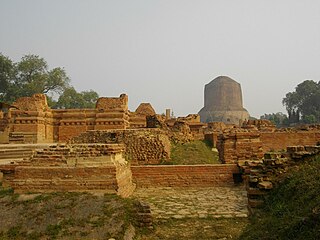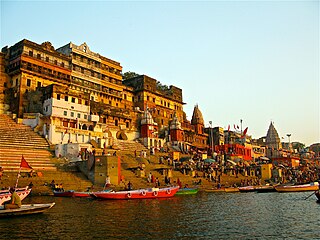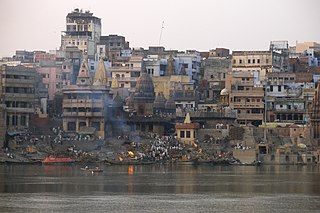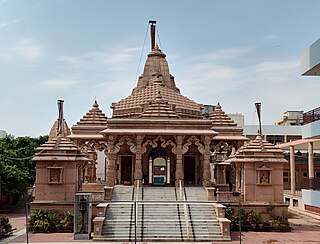
This is a bibliography of notable works about Varanasi.

This is a bibliography of notable works about Varanasi.

Sarnath is a place located 10 kilometres northeast of Varanasi, near the confluence of the Ganges and the Varuna rivers in Uttar Pradesh, India.

The Kashi Vishwanath Temple is a famous Hindu temple dedicated to Shiva. It is located in Vishwanath Gali, near Varanasi, Uttar Pradesh, India. The temple is one of the most sacred Hindu pilgrimage sites and is among the twelve Jyotirlinga, shrines which are said to be the most sacred abodes of Shiva. Standing on the western banks of the Ganges, the presiding deity is known by the names Shri Vishwanath and Vishweshwara, literally meaning Lord of the Universe.

Benares or Banaras State was a kingdom and later princely state in what is today Uttar Pradesh, India. On 15 October 1948, Benares' last ruler signed the accession to the Indian Union.

Dhamek Stupa is a massive stupa located at the archaeological site of Sarnath in the state of Uttar Pradesh, India. Dhamek Stupa marks the precise location where the Buddha preached his first discourse to his first five disciples, and where all five eventually became fully liberated.
Ramnagar is a city, just outside of Varanasi city and a municipal board in Varanasi district in the Indian state of Uttar Pradesh. Ramnagar has a fort known as Ramnagar Fort which is still the residence of King of Varanasi (Benares). He was known as Kashi Naresh meaning king of Kashi and is still regarded by old residents of the city of Varanasi. Ramnagar Fort and its museum are the repository of the history of the kings of Benares and since the 18th century has been the home of Kashi Naresh. Even today the Kashi Naresh is deeply revered by the people of Benares. He is the religious head and the people of Benares consider him the incarnation of Shiva. He is also the chief cultural patron and an essential part of all religious celebrations. Ramnagar is popular for Ramlila that is held annually under the aegis of King of Varanasi

Babu Vibhuti Narayan Singh was the king of Benares, a city considered holy, located in the Indian state of Uttar Pradesh. He was the last Bhumihar Brahmin king of the Kingdom of Kashi.
Central Hindu School, located in Kamachha at the heart of the sacred city Varanasi, is one of India's largest educational institutions. The school is affiliated with the Central Board of Secondary Education and is overseen by Banaras Hindu University. The institution was formerly known as Central Hindu College, and its Senior High School program was previously called Pre University Course.

Ghats in Varanasi are riverfront steps leading to the banks of the Ganges river. The city has 84 ghats. Most of the ghats are bathing and puja ceremonial ghats, while two ghats, Manikarnika and Harishchandra, are used exclusively as cremation sites.

Anokhelal Mishra — also spelled as Anokhe Lal Misra and commonly known as Pandit Anokhelalji — was an Indian Tablā Artist who belonged to the Banaras Gharana of Hindustani classical music.

Varanasi is a city on the Ganges river in northern India that has a central place in the traditions of pilgrimage, death, and mourning in the Hindu world. The city has a syncretic tradition of Muslim artisanship that underpins its religious tourism. Located in the middle-Ganges valley in the southeastern part of the state of Uttar Pradesh, Varanasi lies on the left bank of the river. It is 692 kilometres (430 mi) to the southeast of India's capital New Delhi and 320 kilometres (200 mi) to the southeast of the state capital, Lucknow. It lies 121 kilometres (75 mi) downstream of Prayagraj, where the confluence with the Yamuna river is another major Hindu pilgrimage site.

Music in Varanasi is a tradition linked to the ancient times of the Pauranic legends. Lord Shiva, who is reported to have established this city, was credited with developing music and dance forms. Legend also attributes that Renu}, son of sage Vishvamitra and Mahagobind, was the precursors of music tradition in Kashi (Varanasi) when nymphs (Apsaras), Gandharvas and Kinnaras were the traditional practitioners of this art form, and saint Chaitanya and Vallabhacharya were the pioneers in spreading this music tradition in Varanasi. Notable musicians of Varanasi include the iconic sitar player Ravi Shankar, the Shehnai maestro Bismillah Khan, Sarod maestro Vikash Maharaj and singer Girija Devi. has joined the global bandwagon of UNESCO "Cities of Music" under the Creative Cities Network. Varanasi chosen in music category of creative cities network clearly signifies the rich musical heritage of this ancient city.
Bimla Poddar is an Indian social worker, businessperson, philanthropist and the founder of Jnana Pravaha, a Varanasi based centre for cultural studies, engaged in the efforts to preserve the cultural heritage of India. Under the aegis of the organization, Poddar is involved in activities related to exploration of India's culture and maintains a heritage museum housing artifacts from ancient India. Born and brought up in Varanasi, in the Indian state of Uttar Pradesh, she was married into a rich business family to late Bimal Kumar Poddar and holds the directorship of many of the family concerns which includes Ambuja Cements. She was honoured by the Government of India in 2015 with Padma Shri, the fourth highest Indian civilian award.

Parshvanath Jain temples, Varanasi a group three Jain temples located in Bhelupur, Uttar Pradesh. The temples in Bhelupur were built to commemorate place for three kalyanaka of Parshvanatha.
Varanasi, also known as Kashi, is considered as the religious capital of Hinduism. In the Hindu faith, it is the holiest of all of its cities; the four dhams in the four cardinal directions of the country – Badrinath in the north, Puri in the east, Dwarka in the west and Rameshwaram in the south – are all represented in the city in "archetypal forms" as the presiding deities at Badrinath Ghat, Assi's Jagannath Temple area, Shankudhara Pokhra, and Mir Ghat respectively. Other Hindu holy places, such as the Kedarnath at Kedar Ghat, Mathura at Bakaruia Kund or Nakhi Ghat, Prayagraj (Allahadbad) at Dashahvamedha Ghat, Kamakhya (Assam) at Kamachha, Kurukshetra at Kurkukshetra Kund near Asi, and Lake Manasarovar at Mansarovar near Shyameshvara are a part of the city's religious and cultural heritage.
Varanasi is a city that the Hindus all over the world consider as a holy city and a place of pilgrimage. The centrality of this city in the Hindu worldview has a direct bearing upon its presence in various forms of literature, either directly upon the city itself, or having the city in a kind of central role. Many literary works mention Varanasi occasionally, but that will not be called city literature. The literary presence of the city of Varanasi or Kashi, as it is invariably called in Sanskrit literature, can be conveniently understood by looking at the city literature divided into three groups, based on its language: Sanskrit, Hindi and English.
Shiv Prasaad Singh was an Indian writer, university professor and scholar of the Hindi language. He is well-known for writing novels, short stories and critiques in Hindi. He was formerly a professor of Hindi literature in Benares Hindu University. He received the Kendra Sahitya Akademi Award in 1990 for his novel Neela Chand.
Vasudeva Sharan Agrawala, also Vasudeva Saran Agrawala, (1904–1966), was an Indian scholar of cultural history, Sanskrit and Hindi literature, numismatics, museology, and art history. He received the Sahitya Akademi Award in the Hindi language in 1956 for his prose commentary Padmavat Sanjivani Vyakhya. He was a professor in the Department of Art and Architecture at the Benares Hindu University.
Murkatta is a headless ghost with eyes and mouth in chest and carrying its head tucked under its arm. Murkatta is mentioned in various Nepali culture and traditions. They are considered as the spirits from the dead.

Sarnath Jain Tirth, also called the Shreyanshnath Jain Temple, is a Jain temple in Sarnath. It is located roughly 50 meters to the southeast of Dhamek Stupa.